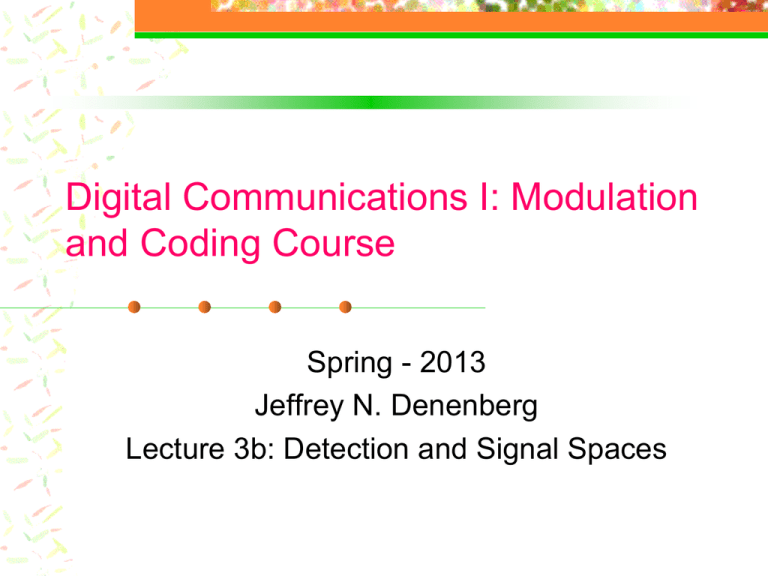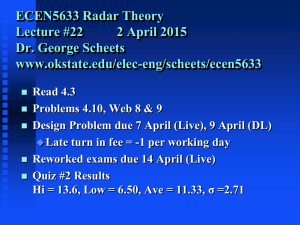Lecture 3b
advertisement

Digital Communications I: Modulation and Coding Course Spring - 2013 Jeffrey N. Denenberg Lecture 3b: Detection and Signal Spaces Last time we talked about: Receiver structure Impact of AWGN and ISI on the transmitted signal Optimum filter to maximize SNR Matched filter receiver and Correlator receiver Lecture 3b 2 Receiver job Demodulation and sampling: Waveform recovery and preparing the received signal for detection: Improving the signal power to the noise power (SNR) using matched filter Reducing ISI using equalizer Sampling the recovered waveform Detection: Estimate the transmitted symbol based on the received sample Lecture 4 3 Receiver structure Digital Receiver Step 1 – waveform to sample transformation Step 2 – decision making Demodulate & Sample Detect z (T ) r (t ) Frequency down-conversion For bandpass signals Received waveform Receiving filter Equalizing filter Threshold comparison Compensation for channel induced ISI Baseband pulse (possibly distored) Lecture 4 Baseband pulse 4 Sample (test statistic) mˆ i Implementation of matched filter receiver Bank of M matched filters s (T t) * 1 z1 (T ) r (t ) sM (T t) * zM z1 z M (T ) z Matched filter output: z Observation vector z r ( t ) s T t) i 1,...,M i( i z ( z ( T ), z ( T ),..., z ( T )) ( z , z ,..., z ) 1 2 M 1 2 M Lecture 4 5 Implementation of correlator receiver Bank of M correlators s 1 (t ) T z1 (T ) 0 r (t ) s M (t ) T 0 z1 z M z Correlators output: z Observation vector z M (T ) z ( z ( T ), z ( T ),..., z ( T )) ( z , z ,..., z ) 1 2 M 1 2 M T zi r(t)si(t)dt i 1,...,M 0 Lecture 4 6 Today, we are going to talk about: Detection: Estimate the transmitted symbol based on the received sample Signal space used for detection Orthogonal N-dimensional space Signal to waveform transformation and vice versa Lecture 4 7 Signal space What is a signal space? Why do we need a signal space? Vector representations of signals in an N-dimensional orthogonal space It is a means to convert signals to vectors and vice versa. It is a means to calculate signals energy and Euclidean distances between signals. Why are we interested in Euclidean distances between signals? For detection purposes: The received signal is transformed to a received vector. The signal which has the minimum Euclidean distance to the received signal is estimated as the transmitted signal. Lecture 4 8 Schematic example of a signal space 2 (t ) s1 (a11,a12) 1 (t ) z (z1, z2) s3 (a31,a32) s2 (a21,a22) Transmitted signal alternatives Received signal at matched filter output s ( t) a ( t) a ( t) s ( a ,a ) 1 11 1 12 2 1 11 12 s ( t) a ( t) a ( t) s ( a ,a ) 2 21 1 22 2 2 21 22 s ( t) a ( t) a ( t) s ( a ,a ) 3 31 1 32 2 3 31 32 z ( t) z ( t) z ( t) z ( z ,z ) 1 1 2 2 1 2 Lecture 4 9 Signal space To form a signal space, first we need to know the inner product between two signals (functions): Inner (scalar) product: * x ( t ), y ( t ) x ( t ) y t ) dt ( Analogous to the “dot” product of discrete n-space vectors = cross-correlation between x(t) and y(t) Properties of inner product: ax ( t ), y ( t ) a x ( t ), y ( t ) * x ( t ), ay ( t ) a x ( t ), y ( t ) x ( t ) y ( t ), z ( t ) x ( t ), z ( t ) y ( t ), z ( t ) Lecture 4 10 Signal space … The distance in signal space is measure by calculating the norm. What is norm? Norm of a signal: 2 x ( t ) x ( t ), x ( t ) x ( t ) dt E x = “length” or amplitude of x(t) ax (t) ax(t) Norm between two signals: d (t)y (t) x ,y x We refer to the norm between two signals as the Euclidean distance between two signals. Lecture 4 11 Example of distances in signal space 2 (t ) s1 (a11,a12) E1 d s1 , z 1 (t ) z (z1, z2) E3 s3 (a31,a32) d s3 , z E2 d s2 , z s2 (a21,a22) The Euclidean distance between signals z(t) and s(t): 2 2 d s ( t ) z ( t ) ( a z ) ( a z ) s , z i i 11 i 22 i i 1 , 2 , 3 Lecture 4 12 Orthogonal signal space N-dimensional orthogonal signal space Nis characterized by N linearly independent functions j (t)j1 called basis functions. The basis functions must satisfy the orthogonality condition 0 t T ( t ), ( t ) ( t )( t ) dt K i j i i ji j,i 1,..., N 0 T * j where 1 ij 0 ij ij If all K i 1, the signal space is orthonormal. See my notes on Fourier Series Lecture 4 13 Example of an orthonormal basis Example: 2-dimensional orthonormal signal space 2 ( t ) cos( 2t /T) 0t T 2 (t ) 1 T (t) 2 sin( 2t /T) 0t T 2 T T 0 1(t),2(t) 1(t)2(t)dt0 1 (t ) 0 1(t) 2(t) 1 Example: 1-dimensional orthonormal signal space 1 (t ) 1(t) 1 1 T 0 1 (t ) 0 T t Lecture 4 14 Signal space … si (t )iM1 Any arbitrary finite set of waveforms where each member of the set is of duration T, can be expressed as a linear combination of N orthonogal waveforms j (t)N where N M . j 1 N si(t) a j(t) ij j 1 i 1,...,M NM where 1 1 * j 1,...,N a s ( t ), ( t ) s ( t ) ( t ) dt 0 t T ij i j i j i 1 ,..., M K K j j0 T s (a ,a ,..., a ) i i1 i2 iN Vector representation of waveform Lecture 4 N E Kj aij i 2 j 1 Waveform energy 15 Signal space … N si(t) a j(t) ij s (a ,a ,..., a ) i i1 i2 iN j 1 Waveform to vector conversion Vector to waveform conversion 1 (t ) si (t ) 1 (t ) T ai1 0 N (t ) T 0 aiN a i1 a iN Lecture 4 sm sm a i1 a iN ai1 N (t ) aiN 16 si (t ) Example of projecting signals to an orthonormal signal space 2 (t ) s1 (a11,a12) 1 (t ) s3 (a31,a32) s2 (a21,a22) Transmitted signal alternatives s ( t ) a ( t ) a ( t ) s ( a , a ) s ( t ) a ( t ) a ( t ) s ( a , a ) s ( t ) a ( t ) a ( t ) s ( a , a ) 1 11 1 12 2 1 11 12 2 21 1 22 2 2 21 22 3 31 1 32 2 3 31 32 T a ij si(t)j(t)dt j 1,...,N i 1,...,M Lecture 4 0 0 t T 17 Signal space – cont’d To find an orthonormal basis functions for a given set of signals, the Gram-Schmidt procedure can be used. Gram-Schmidt procedure: N M Given a signal set si (t )i 1 , compute an orthonormal basis j (t)j1 ( t ) s ( t ) /E s ( t ) /s ( t ) i 1. Define 1 1 1 1 1 1 ( t ) s ( t ) s ( t ), ( t ) ( t ) 2. For i 2,...,M compute d i i i j j j 1 t) d t)/d t) If di (t) 0 let i( i( i( If di (t) 0 , do not assign any basis function. 3. Renumber the basis functions such that basis is ( t), ( t),..., ( t) 1 2 N This is only necessary if di (t) 0for any i in step 2. Note that N M Lecture 4 18 Example of Gram-Schmidt procedure Find the basis functions and plot the signal space for the following transmitted signals: s1 (t ) s2 (t ) A T 0 0 T t T t A T Using Gram-Schmidt procedure: T s1(t)A 1(t) 1 (t ) t) dtA 1 E 1 s 1( 0 2 2 1(t)s1(t)/ E t)/A 1 s 1( 2 s2(t), 1(t) 0 s2(t)1(t)dtA T d2(t)s2(t)(A ) t)0 1( s2(t)A 1(t) 1 T s1 (A ) s2 (A ) 0 T t s2 -A Lecture 4 s1 0 19 A 1 (t ) Implementation of the matched filter receiver Bank of N matched filters z1 (T t) 1 r (t ) N(T t) zN z1 z N Observation vector z z N si(t) a j(t) ij j 1 i 1,...,M NM z(z1,z2,..., zN) zj r (t) T t) j 1,...,N j( Lecture 4 20 Implementation of the correlator receiver Bank of N correlators 1 (t ) T z1 0 r (t ) N (t ) T 0 N si(t) a j(t) ij zN r1 r N z z i 1,...,M j 1 z(z1,z2,..., zN) NM T zj r(t) j(t)dt j 1,...,N 0 Lecture 4 21 Observation vector Example of matched filter receivers using basic functions s1 (t ) 1 (t ) s2 (t ) 1 T A T T 0 0 T t A T t 0 T t 1 matched filter 1 (t ) r (t ) 1 T 0 z1 z1 z z T t Number of matched filters (or correlators) is reduced by 1 compared to using matched filters (correlators) to the transmitted signal. Lecture 4 22 White noise in the orthonormal signal space AWGN, n(t), can be expressed as ~ ˆ(t)n n (t)n (t) Noise projected on the signal space which impacts the detection process. Noise outside of the signal space N ˆ(t) n nj t) j( Vector representation of j 1 n n (t), t) j 1,...,N j j( ~ n (t), j(t) 0 j 1,...,N Lecture 4 nˆ (t ) n(n ,n n 1 2,..., N) n N independent zero-mean Gaussain random variables with nj)N variance var( 0/2 j j 1 23








